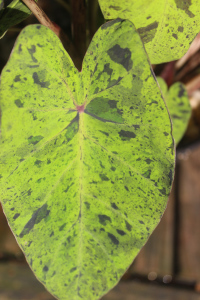I have not always been the FLOWER.
My first love was leaves. I collected leaves. Pressed leaves into pictures. Made stationery with embedded leaves…
In my home there are leaves on the rugs and floor clothes and walls and sofas…
So today I want to share an unusual leaf.
I have been watching this plant grow for months.
It was a gift from ” My Friend the Fairy.” (See post. She is adorable)
The plant is a “Queen of the Night” , “Night Blooming Cereus” or Epiphyllum oxypetallum.
Its nickname is also Gooseneck cactus. Now I know why. One leaf decided it needed to be longer. So it added another lobe on the tip.
This stem and leaf first looked like a rising cobra’s head several months ago.
It elongated and has now sprouted side leaflets.
The leaves are very thick and the venation is visually absent,

except for the midrib seen underneath.
The midrib sends vein offshoots to each leaflet.
The underside of the main leaf has rootlets which is typical of an epiphyte.
Lastly, I would like to include a photo that those who know me will appreciate.
Photo shoot carnage. Positioning leaves lead to a spill. Another mess. I wonder what punishment will be bestowed upon me by my facedown fairy godmother. She’s mean.

The Queen only blooms once every couple of years, so I will enjoy its leaves in the meantime.
FLOWER















